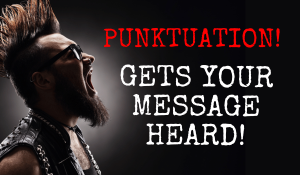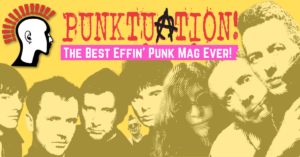Punktuation’s Molly Tie takes us on a tour of a punk subgenre world where rockabilly, garage, surf, country, and blues cross-pollinates with punk – welcome to planet Psychobilly!
Perhaps the reason punk has stayed so vibrant and vital is that there have been numerous reimaginings, tweakings and re-workings of the original sound since that initial cohort of bands, giving us a pleasing number of spin-offs, hybrids, and subgenres.
It is rock mathematics – take certain aspects of punk, add a bit of something else and voila! You have a brand-new subgenre- keeping the scene alive and giving us all a bit of variety. Take punk as your base ingredient, add a bit of mandolin and Irish Civil War imagery and you get Celtic punk. Add pub rock and football chants and get Oi punk. Chuck in some Feminist manifestos and political slogans and what might you get? Riot Grrrl.

So, what happens when you add punk energy and attitude to early rock ‘n’ roll influences and instrumentation, then throw in some Nosferatu t-shirts and fishnet stockings? Psychobilly! We’ve (probably) all heard the term, but what exactly is this subgenre of punk all about? Where did it come from and is it still going? Hold on to your quiffs and let’s take a deep dive to find out…
What Exactly is it?
Psychobilly came about in the mid-1970s but really took off as a coherent subgenre of punk in the 1980s. The ‘-billy’ aspect of its name is a reference to rockabilly which it certainly borrows quite a lot from, namely its roots in 1950s rock ‘n’ roll. The ‘psycho’ comes from the use of horror and sci-fi imagery that is an essential part of both psychobilly aesthetic and the lyrical content.
Psychobilly fuses elements of rockabilly with punk rock- it’s like rockabilly but louder, faster and with a heavy dose of imagery and aesthetics from horror, sci-fi and old movies to deliver a unique sound along with an instantly recognisable fashion look.
Looking at psychobilly bands on stage, you can see the presence of classic rock ‘n’ roll instrumentation with an upright double bass being a likely addition to the band, probably a hollowbody guitar (a semi-acoustic guitar originating in the 1930s) along with your usual suspects of drums and vocals.

The resulting sound is a mixture of simple punk chords oscillating with rockabilly style pluckings and riffs; a slap bass and snarling, sinister vocals. In many cases, the double bass has become its own character in the band- either elaborately decorated with stickers and paints (a la Patricia Day from the HorrorPops) or shaped into a grim centrepiece such as the coffin-shaped instrument of Kim Nekroman from Nekromantix.
The double bass also provides a convenient piece of equipment for onstage theatrics and gymnastics- shows by bands like Australian outfit The Living End often involve frontman Chris Cheney jumping off of bassist Scott Owen’s stringed appendage with reckless abandon. You can’t do that with a glockenspiel.

Whilst the sound may be heavy the lyrics are often not- their use of all that is macabre and monstrous is often tongue-in-cheek and a bit camp, taking inspiration from monster stories (Human Fly, The Cramps) or twisted fairy tales (Lil’ Red Riding Hood- The Meteors). It is rare to find political content in psychobilly lyrics- a conscious choice by many bands to avoid any topics or stances that were potentially divisive and to focus on having fun and staying chilled. In contrast to other waves of punk that take authenticity and messaging pretty seriously, psychobilly prioritises the kitsch and cheesy.
The provenance of punk is fiercely debated – did it start on the streets of London in the mid-70s with bands like The Sex Pistols and Siouxsie and the Banshees or can we in fact trace it back to the Avant-Garde scene of New York and Warhol’s Factory misfits and CBGBs regulars?
The origins of psychobilly mirror the same conundrum – were bands like The Cramps (formed in 1976) the godparents of the subgenre or should we fast forward a bit to British shores where we saw other potential progenitors like The Meteors?
Certainly, The Cramps are one of the most widely recognised psychobilly bands, coming up through the 1970s thriving underground New York punk scene. They seem to fit the bill- the look is certainly there, they share a lot of the hallmarks of the general psychobilly sound and they have been absorbed into the history of the movement over the years, their 1984 compilation album Bad Music for Bad People considered essential listening.
However, The Cramps themselves were not that keen to be labelled as psychobilly – claiming their use of electric bass and a slower pace mean they are precluded from the definition even though they were actually the first band to include the moniker on their gig flyers.
They used what they described as ‘carny language’ on the flyers for their shows in order to entice the curious to come – they appropriated the term ‘psychobilly’ (originally used in a Johnny Cash song) to put on their flyers and along with references to voodoo and shock rock.
But over the pond in the UK, there is another challenger for the crown of ‘psychobilly starter’- British band The Meteors who are considered one of the main originators of the genre and a consistent example of a textbook psychobilly band. The Meteors blended themes of horror, punk, and rockabilly – the blueprint for the psychobilly genre and having formed in the early 1980s in London, they have released over 20 albums in their 40-year career. In particular albums like their debut In Heaven (1981) and Wreckin’ Crew in 1983 are considered seminal albums in the genre.
Not only did Britain have the bands, they also had somewhere to play. Every good music movement needs a club and if the Madchester scene had the Manchester Hacienda and dance/techno had London’s Ministry of Sound, then British psychobilly had Klub Foot nightclub in Hammersmith.

It was described as the focal point for the whole scene and emerging psychobilly bands were put on there in their droves. In 1984 the club even put out their own compilation in 1984 entitled Stomping at The Klub Foot– featuring bands they had championed over the years like The Guana Batz, Restless and The StingRays.
Following a significant success in Britain, psychobilly spread throughout Europe with some key bands of the genre forming around the late 1980s. Demented Are Go formed in Wales in 1982 and after the release of their debut album In Sickness & In Health, they developed a large psychobilly and punk rock following all over Europe.
Europe, and in particular Britain, became so desirable that some American bands relocated in order to gain followings from a more enthusiastic crowd. Lack of airplay and touring opportunities kept American psychobilly relatively dormant for years.
One exception was the American act The Reverend Horton Heat who formed in Texas in 1985. Their single Psychobilly Freakout was a modest hit in the US and did help widen the scope a bit.
It was perhaps this breakthrough that led to an increase in success for the genre in the US in the 1990s. Punk rock scenes in California began to adopt psychobilly bands into the general fold and the popularity of bands like the Misfits and Social Distortion helped prop up the scene. It is also observed that the large Latino community who revered early rock and roll icons such as Elvis and the style that goes with it, probably helped as they were drawn in by the references to rock gods and pin-ups of yesteryear.
By the mid to late 1990s, America had thrown itself onto the psychobilly train and began nurturing and promoting their own homegrown artists. West Coast band Tiger Army found success after their 1999 self-titled debut album and signed to Tim Armstrong’s Hellcat Records which developed a roster filled with other psychobilly acts such as Devil’s Brigade and HorrorPops.
By the early 2000s, psychobilly had re-established itself as a legitimate part of the punk rock family with psychobilly bands touring with a diverse range of acts such as Dead Kennedys, Dick Dale, and Chuck Berry – demonstrating that they are appreciated by both sides of their main influences- punk and rock ‘n’ roll.
Influences
The theatrical nature of psychobilly – the distinctive stage costumes and otherworldly lyrical themes show a clear homage to acts such as shock rock artist Screamin’ Jay Hawkins in the 1950s.
Hawkins was an American singer-songwriter and musician notorious for his powerful, operatic vocals and flamboyant performances, obvious in songs such as I Put A Spell on You, Little Demon and Whistlin’ Past the Graveyard.
As a child, he was somewhat of an opera aficionado and idolised the likes of Paul Robeson and Enrico Caruso as well as jazz musicians like Dizzy Gillespie and blues artists like Lightnin’ Hopkins and H Bomb Ferguson.
Certainly, psychobilly’s penchant for macabre stage props and lively performances can be traced back to some early blues pioneers. The Cramps were heavily influenced by 1950s rock and roll and as well as Hawkins, were fans of Sun Records tracks and old school country/rock artist Hasil Adkins whose song they covered in their album Bad Music for Bad People.
It is common for rockabilly to be confused with psychobilly but in fact, psychobilly takes elements of rockabilly and then fuses them with ’70s punk rock and ’50s American rock. The sound is harder and faster and although there is often a retaining of American rock n roll riffs and guitar work, the production values and vocals are more punk. It is rockabilly but roughed up a bit- hair dishevelled, eyeliner running, buttons undone and slurping an Alka-Seltzer after a big night out.
Fans of the genre go beyond those obvious influences and point to the extensive array of musical sounds that contribute to a psychobilly sound and there’s a lot more punk in there then may be assumed- from hardcore, to street punk and Oi punk.
Hilary Okun, publicist for Epitaph and Hellcat Records, notes: “The music appeals to fans of punk, indie, metal, new wave, goth, rockabilly, surf, [and] country.”
Psychobilly is now just as understood to be a style look than it is a genre of music – the aesthetic is such an important part of the scene, the opportunities for dressing up part of what makes the genre both so appealing and so fun. It goes without saying, that due to the influence of the 1950s and horror, this features in a lot of the dress. Coloured hair in tall quiffs, B-Movie imagery on shirts and dresses, hot rod style clothes and fetish wear all feature heavily even today.
The scene is still thriving with numerous promoters putting on psychobilly gigs, festivals, reunions, and club nights all over the world. Bedlam Breakout, Pompey Rumble, Psychobilly Meeting, Rockabillaque are just some examples of regular events that are put on to celebrate the music, looks, creativity and camaraderie of the psychobilly scene.
So, if you’re in the mood for a bit of slap bass, stacked quiffs and zombie references then grab an album by Tiger Army and slam dance across your living room floor with The Cabinet of Dr. Caligari playing in the background.
If you enjoyed this, you might like this…
I’m Molly Tie- I Love punk! I play drums (badly), write a lot about punk (not as badly) and I’m particularly interested in issues relating to women in the music scene.




 Did you know that we are 100% DIY? We run our own game. No one dictates to us, and no one drives what we can or cannot put on our pages – and this is how we plan to continue!
Did you know that we are 100% DIY? We run our own game. No one dictates to us, and no one drives what we can or cannot put on our pages – and this is how we plan to continue!
